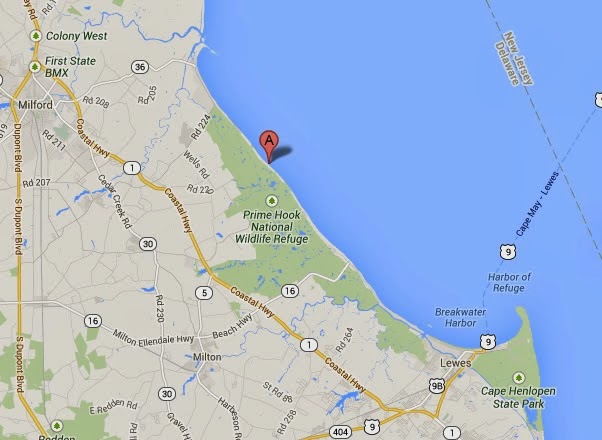The beautiful but windy beach today
On the bird front, there wasn't much action today. I tried a brief sea watch after lunch, but given the west winds, this quickly proved futile as I expect it would be. Instead of birding, I decided at the end of the day to drag out my camera and do some photography since the light was perfect. There was a sheltered, water-filled depression on the beach that has held birds during most of my stay here on Sullivan's Island SC. I found quite a few shorebirds cycling through the area late this afternoon. These included Willet, Black-bellied Plover, Piping plover, Sanderling, Dunlin, Red knot, and, unusual around here, a single Purple sandpiper. By laying down in water in the depression and crawling slowly forward, I was able to closely approach a group of ~80 birds of assorted species. I know I was within 11.5 feet of them since my 400mm wouldn't focus! I spent most of time my photographing the ~40 Red knots in the group. I walked away with several really nice shots, and I got a clear shot of a banded bird that I hope to find a way to track in the next few days. I submitted an online report to the USGS bird banding program.
***click for bigger images***
Red knot just at sunset today
Red knot from a bit earlier in the day
Red knot 94X from today
Red knots are some of the most accomplished migrants in the avian world. Some of these birds make a 20,000-mile round trip migration from the Arctic in the Northern Hemisphere to Tierra del Fuego in the Southern Hemisphere. The birds shown here are the rufa subspecies, a portion of which winter in the southeastern United States. While they are a dull gray at this time of year, they are a nice rufous color during the breeding season. There is one particularly famous Red knot, B95, who has now made this 20,000-mile journey at least 20 times! You can read all about him here. He has even had entire books written about him!
Red knot migration routes
Post-breeding Red knot (from my stock)
with lingering red on breast, sides
These birds must eat a lot of food to fuel such long migrations. One of the areas that is particularly critical to Red knot migration is the Delaware bayshore. The Delaware bay is home to many horseshoe crabs, and these ancient beasts come ashore to lay their eggs on the beach in May. These eggs provide valuable fuel for the northbound Red Knots that stop to rest and feed along this stretch at this same time of year.
Red knots and Horseshoe crabs on
the Delaware Bayshore
One of projects directed by The Conservation Fund for which I am raising money is Fowler Beach in Delaware. The Fowler Beach properties are adjacent to the Prime Hook National Wildlife Refuge (Point A on map below). Acquiring the coastline between the refuge and the Delaware Bay has been a top priority for the Prime Hook Refuge for many years. The Fowler Beach properties provide unique opportunity to effectively secure three miles of coastline along the Delaware bay. This coastline provides critical habitat for migrating shorebirds including the imperiled Red knot and excellent spawning grounds for the horseshoe crab. Protecting the properties eliminates threats of development adjacent to the refuge and enhances existing wildlife habitat at Prime Hook NWR. So, when you donate, you ensure that the Red knot has a place to refuel on his amazing migration each year! He flies more miles every year than I'm going to bike this single year!









Shouldn't this be "Day 46" :)
ReplyDeleteThanks for the little lesson about red knots and horseshoe crabs.
ReplyDeleteWhy does it cry, Sméagol?
ReplyDelete